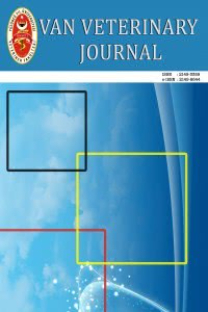Dog bite wounds: A retrospective study (114 cases)
Köpek ısırık yaraları: Bir retrospektif çalışma (114 vaka)
___
- Appleby DL, Bradsaw LW, Casey RA (2002): Relationship between aggressive and avoidence behaviour by dogs and their experience in the first six months in life. Vet. Rec. 150: 434-438.
- Cowell AK, Penwick RC (1989): Dog bite wounds: a study of 93 cases. Comp. Contin. Educ. Prac. Vet. 11:313-320.
- Davidson EB (1998): Managing bite wounds in dog and cats. Part I. Comp. Contin. Educ. Prac. Vet.20: 811-820.
- Fleisher GR, Boenning DA (1998): The treatment of animal bites in humans. Comp. Contin. Educ. Prac. Vet.3: 366-370.
- Griffin GM, Holt DE (1997): Dog bite wounds: bacteriologie and treatment outcome in 37 cases. J.Am. Anim. Hosp. Assoc. 37: 455-460.
- Hart BL, Hart LA (1985): Selecting pet dogs on the basis of cluster analyses of breed behaviour profiles and gender. J. Am. Vet. Med. Assoc. 186: 1181-1185.
- Harari J (1993): Surgical Complications and Wound healing in the Small animal Practice. W.B. Sounders, Philadephia, P.A, USA.
- Holt DE, Griffin GM (2000): Bite wounds in dogs and cats. Vet. Clin. North. Am. Small. Anim. Pract30: 669-679.
- Kelly PJ, Mason JE, Matthewman LA (1992): Pathogens in dog bite wounds in dogs in Harare. Zimbabwe. Vet.Rec. 131: 464-466.
- Kolata RJ, Kraut NH, Johnston DE (1974): Patterns of trauma in urban dogs and cats: a study of 1000 cases. J. Am. Vet. Med. Assoc. 164: 499-502.
- Neal TA, Key JC (1976): Principles of treatment of dog bite wounds. J.Am. Anim. Hosp. Assoc. 12: 657-660.
- Overall K (1997): Clinical Behavioral Medicine for Small Animals. Mosby, St. Louis, MO,.
- Shamir CK, Leisner S, Klement E, Gönen E, Johnstone, DE (2002): dog bite wounds in dogs and cats: a retrosrective study of 196 cases. J. Vet. Med. A. 49:107-112.
- Swaim SF, Henderson RA (1997): Small Animal Wound Management. Lippincott, Williams and Williams, Baltimore.
- ISSN: 1017-8422
- Yayın Aralığı: 3
- Başlangıç: 1990
- Yayıncı: Yüzüncü Yıl Üniv. Veteriner Fak.
Physical, chemical, microbiological and sensory characteristics of some fruit-flovored yoghurt
ZEKAİ TARAKÇI, ERDOĞAN KÜÇÜKÖNER
Dog bite wounds: A retrospective study (114 cases)
Egzersiz elektrokardiyografik metotların karşılaştırılması ve yariş atlarında uygulama teknikleri
Remzi GÖNÜL, M. Erman OR, H. Tamer DODURKA
Farklı hayvan türlerine ait çiğ etlerin SDS-PAGE yöntemiyle belirlenmesi üzerin bir araştırma
SÜLEYMAN KOZAT, Nazmi YÜKSEK, NURİ ALTUĞ, Zahid Tevfik AĞAOĞLU, Faruk ERÇİN
Yaralıoğlu Sema GÜRGÖZE, NİHAT ŞINDAK, Seval YILMAZ, Hasan SERTKAYA, Temizer Sema OZAN
Polyakrilamid jel özoelektrik fokuslama tekniğinin (PAGIF) et türlerinin ayırımında kullanılması
